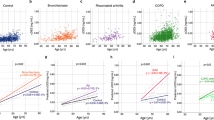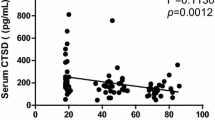Abstract
Background and aims: The extracellular matrix (ECM) undergoes constant dynamic changes; proteolytic enzymes, particularly the serine proteases plasmin, trypsin and elastase, catalyze critical functions in these processes. Notably, ECM degradation disorders have been reported in various morbid conditions, including cardiac infarction, atheromatosis, and neoplastic diseases, indicating a physiological requirement for proper ECM maintenance. Here we define the role of proteolytic enzymes in the development of aging by assessing changes in proteolytic enzyme activity in serum during aging in rats. Methods: The activities of trypsin, elastase and plasmin in rat serum were determined by the fluorometric method using AMC-labeled substrates in 34 Wistar rats divided into four age groups: 3 month-olds (n=8), 9 month-olds (n=8), 15 month-olds (n=8) and 24 month-olds (n=10). Results: Analysis of proteolytic enzyme activity in four age-dependent groups revealed that in comparison to their 3, 9, and 24 month-old counterparts, the 15 month-old rats exhibited a statistically significant increase in average elastase activity. In accordance with previous studies, a statistically significant increase in trypsin levels was found in the 3 month-old rats, suggesting that trypsin activity decreases with age. Average plasma plasmin activity in the 24 month-old rats was, moreover, statistically significantly higher than that in the other three age groups. Conclusions: Analysis of combined proteolytic activity indicates that age-dependent patterning of blood serine protease enzyme activity may be related to age-related diseases.
Similar content being viewed by others

REFERENCES
Jariel-Encontre I, Salvat C, Stefe AM, Pariat M, Acquaviva C. Complex mechanisms for c-fos and c-jun degradation. Mol Biol Rep 1997; 24: 51–6.
Baricos WH, Cortez SL, El-Dahr SS, Schnaper HW. ECM degradation by cultured human mesangial cells is mediated by a PA/plasmin/MMP-2 cascade. Kidney Int 1995; 47: 1039–47.
Stryer L, Augustyniak J, Michejdy J. Biochemistry. Warszawa PWN: 2003; 236: 265 274–5.
Elias E, Redshaw M, Wood T. Diagnostic importance of changes in circulating concentrations of immunoreactive trypsin. Lancet 1977; 2: 66–8.
Lake-Bakaar G, Rubio CE, McKavanagh S, Potter J, Summerfield JA. Metabolism of 125 [-labelled trypsin in man: evidence for recirculation. Gut 1980; 21: 580–6.
Naohiko K, Satoshi H, Yoji N, Keisuke M, Yoshiaki T, Satoshi M. Expression of trypsin by epithelial cells of various tissues, leukocytes, and neurons in human and mouse. Am J Pathol 1998; 153: 937–9.
Mahmoud Z, Ladislas R, Dominique C, Pierre-Jean T, Latifa B, Pierre D. Serum elastase activity, serum elastase inhibitors, and occurrence of carotid atherosclerotic plaques. Circulation 2002; 105: 2638–45.
Robert L, Jacobs MP, Frances C, Godeau G, Hornebeck W. Interaction between elastin and elastases and its role in the aging of the arterial wall, skin and other connective tissues. Mech Aging Dev 1984; 28: 155–66.
Robert L, Robert AM, Jacotot B. Elastin-elastase-atherosclerosis revisited. Atherosclerosis 1998; 140: 281–95.
Roszkowska-Jakimiec W, Worowska A, Gacko M, Maksimowicz T. Proteases of neutrophilic granulocytes. Post Hig Med Dosw 2002; 1: 73–92.
Beynon RJ, Bond JS. Proteolytic Enzymes (a practical approach). Oxford University Press, Oxford, 1989.
Jang X, Hand AR, Shujing S, Cone RE, O’Rourke J. Enhanced tissue plasminogen activator synthesis by the sympathetic neurons that innervate aging vessels. J Neurosci Res 2003; 71: 567–74.
Makoto A, Yuichi H, Nobuaki O, Hiromi H, Taiichiro S, Toyohiko A. Plasminogen activator-plasmin system potentiates the proliferation of hepatocytes in primary culture. Thromb Res 2002; 107: 169–74.
Wojtowicz-Praga SM, Dickson RB, Hawkins MJ. Matrix metalloproteinase inhibitors. Invest New Drugs 1997; 15: 61–7.
Woessner JF. Matrix metalloproteinase inhibition. Ann NY Acad Sci 1999; 878: 388–403.
Leppert D, Lindberg RLP, Kappos L. Matrix metalloproteinases: multifunctional effectors of inflammation in multiple sclerosis and bacterial meningitis. Brain Res Rev 2001; 36: 249–57.
Kerkela E, Saarialho-Kere U. Matrix metalloproteinases in tumor progression: focus on basal and squamous cell skin cancer. Exp Dermatol 2003; 1: 109–25.
Jin-Moo L, Ke-Jie Y, Idar H, Shawei Ch. Matrix metalloproteinase-9 and spontaneous hemorrhage in an animal model of cerebral amyloid angiopathy. Ann Neurol 2003; 54: 379–82.
Watanabe N, Ikeda U. Matrix metalloproteinases and atherosclerosis. Curr Atheroscler Rep 2004; 6: 112–20.
Zimmerman M, Ashe B, Yurewicz EC, Patel G. Sensitive assays for trypsin, elastase and chymotrypsin using new fluorogenic substrates. Anal Biochem 1977; 78: 47–51.
Cuervo AM, Dice JF. Lysosomes, a meeting point of proteins, chaperones and proteases. J Mol Med 1998; 76: 6–12.
Smith RE, Bissei ER, Mithell AR, Pearson KW. Direct photometric and fluorometric assay of proteinases using substrates containing 7-amido-4-trifluoromethylcoumarin. Thromb Res 1980; 17: 393–402.
Heidland A, Sebekova K, Paczek L, Teschner M, Dammrich J, Gaciong Z. Renal fibrosis: Role of impaired proteolysis and potential therapeutic strategies. Kidney Intern 1997; 52 (Suppl 6): S32–5.
Cushman M, Rozenn NL, Lewis HK, Bruce MP, Elizabeth MM. Fibrinolytic activation markers predict myocardial infarction in the elderly. The cardiovascular health study. Arterioscler Thromb Vasc Biol 1999; 19: 493–8.
Munkvad S. Fibrinolysis in patients with acute ischaemic heart disease. Dan Med Bull 1993; 40: 383–408.
Ranson M, Andronicos NM. Plasminogen binding and cancer: promises and pitfalls. Front Biosci 2003; 8: S294–304.
Zhu LX, Geng XP, Fan ST. Spontaneous rupture of hepatocellular carcinoma and vascular injury. Arch Surg 2001; 136: 682–7.
Balo J. Connective tissue changes in atherosclerosis. In Hall DA, ed. International review of connective tissue research, Vol I. New York: Academic Press, 1963: 241–306.
Bizbiz L, Alperovitch A, Robert L. Aging of the vascular wall: serum concentration of elastin peptides and elastase inhibitors in relation to cardiovascular risk factors. The EVA study. Atherosclerosis 1997; 131: 73–8.
Oho S, Saley SJ, Koo EW. Increased elastin-degrading activity and neointimal formation in porcine aortic organ culture: reduction of both features with a serine proteinase inhibitor. Arterioscler Thromb Vasc Biol 1995; 15: 2200–6.
Ooyama T, Sakamato H. Elastase in the prevention of arterial aging and the treatment of atherosclerosis. Ciba Found Symp 1995; 192: 307–17.
Gaciong Z, Paczek L, Bojakowski K, Socha K, Wisniewski M, Heidland A. Beneficial effect of proteases on allograft arteriosclerosis in a rat aortic model. Nephrol Dial Transplant 1996; 11: 987–9.
Religa P, Bojakowski K, Gaciong Z, Thyberg J, Hedin U. Arteriosclerosis in rat aortic allograft: dynamics of cell growth, apoptosis and expression of extracellular matrix proteins. Mol Cell Biochem 2003; 249: 75–83.
Lehmann PV. Immunomodulation by proteolytic enzymes. Nephrol Dial Transplant 1996; 11: 953–5.
Zhang B, Ye S, Herrmann SM et al. Functional polymorphism in the regulatory region of gelatinase B gene in relation to severity of coronary atherosclerosis. Circulation 1999; 99: 1788–94.
Kluft C. The fibrynolytic system and thrombotic tendency. Pathophysiol Haemost Thromb 2004; 33: 425–9.
Bouck N, Stellmach V, Hsu SC. How tumors become angiogenic. Adv Cancer Res 1996; 69: 135–74.
Chapman HA, Stone OL. Co-operation between plasmin and elastase in elastin degradation by intact murine macrophages. Biochem J 1984; 222: 721–8.
Author information
Authors and Affiliations
Corresponding author
Rights and permissions
About this article
Cite this article
Paczek, L., Michalska, W. & Bartlomiejczyk, I. Proteolytic enzyme activity as a result of aging. Aging Clin Exp Res 21, 9–13 (2009). https://doi.org/10.1007/BF03324892
Received:
Accepted:
Published:
Issue Date:
DOI: https://doi.org/10.1007/BF03324892



